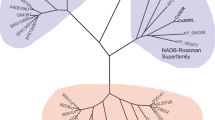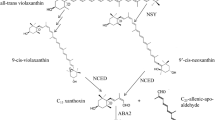Abstract
C6 compounds are the major fraction of the volatile profiles of grape berries, contributing the typical ‘green’ aroma to the grape and wine. Hydroperoxide lyase (HPL) catalyzes the cleavage of fatty acid hydroperoxides to produce C6 compounds. Two hypothetical genes, VvHPL1 and VvHPL2 were cloned from grape berries (Vitis vinifera L. Cabernet Sauvignon). Bioinformatics analysis revealed that the proteins encoded by these two genes both belong to subfamily of cytochrome P450 and contain typical conserved domains of HPLs, and have high identity with HPLs from other plants. Prokaryotically-expressed VvHPL1 and VvHPL2 with thioredoxin-6xHis-fusion partner were confirmed to have enzymatic activity. VvHPL1 is specific for 13-HPOD (T) producing C6 aldehydes with relatively higher activity and VvHPL2 catalyzes the cleavage of both 9- and 13-hydroperoxides producing C6 aldehydes and C9 aldehydes respectively. Analysis of real time-PCR showed that VvHPL2 was highly expressed in the leaves and the flowers of the grapes, while relatively low transcript abundance was detected in the berries, tendril and stems; VvHPL1 had high expression in all detected tissues. During grape berry development, the expression of these two isogenes presented similar trends with a rapid increase after veraison and a decrease at full-ripen stage, which roughly corresponded to the accumulation of their volatile products. These data lay an essential foundation for further study on the accumulation and control of C6 volatiles in grape berries.





Similar content being viewed by others
References
Feussner I, Wasternack C (2002) The lipoxygenase pathway. Ann Rev Plant Biol 53:275–297. doi:10.1146/annurev.arplant.53.100301.135248
Matsui K (2006) Green leaf volatiles: hydroperoxide lyase pathway of oxylipin metabolism. Curr Opin Plant Biol 9(3):274–280. doi:10.1016/j.pbi.2006.03.002
Shiojiri K, Kishimoto K, Ozawa R, Kugimiya S, Urashimo S, Arimura G, Horiuchi J, Nishioka T, Matsui K, Takabayashi J (2006) Changing green leaf volatile biosynthesis in plants: an approach for improving plant resistance against both herbivores and pathogens. Proc Natl Acad Sci USA 103(45):16672–16676. doi:10.1073/pnas.0607780103
Morant M, Bak S, Moller BL, Werck-Reichhart D (2003) Plant cytochromes P450: tools for pharmacology, plant protection and phytoremediation. Curr Opin Biotechnol 14(2):151–162. doi:10.1016/s0958-1669(03)00024-7
Bate NJ, Sivasankar S, Moxon C, Riley JMC, Thompson JE, Rothstein SJ (1998) Molecular characterization of an Arabidopsis gene encoding hydroperoxide lyase, a cytochrome P-450 that is wound inducible. Plant Physiol 117(4):1393–1400
Howe GA, Lee GI, Itoh A, Li L, DeRocher AE (2000) Cytochrome P450-dependent metabolism of oxylipins in tomato. Cloning and expression of allene oxide synthase and fatty acid hydroperoxide lyase. Plant Physiol 123(2):711–724
Matsui K, Ujita C, Fujimoto S, Wilkinson J, Hiatt B, Knauf V, Kajiwara T, Feussner I (2000) Fatty acid 9-and 13-hydroperoxide lyases from cucumber. FEBS Lett 481(2):183–188
Myung K, Hamilton-Kemp TR, Archbold DD (2006) Biosynthesis of trans-2-hexenal in response to wounding in strawberry fruit. J Agric Food Chem 54(4):1442–1448. doi:10.1021/jf052068+
Gomi K, Yamasaki Y, Yamamoto H, Akimitsu K (2003) Characterization of a hydroperoxide lyase gene and effect of C6-volatiles on expression of genes of the oxylipin metabolism in Citrus. J Plant Physiol 160(10):1219–1231
Chehab EW, Raman G, Walley JW, Perea JV, Banu G, Theg S, Dehesh K (2006) Rice hydroperoxide lyases with unique expression patterns generate distinct aldehyde signatures in Arabidopsis. Plant Physiol 141(1):121–134. doi:10.1104/pp.106.078592
Kalua CM, Boss PK (2009) Evolution of volatile compounds during the development of Cabernet Sauvignon grapes (Vitis vinifera L.). J Agric Food Chem 57(9):3818–3830. doi:10.1021/jf803471n
Ribéreau-Gayon R (2006) Handbook of enology volume 1: The microbiology of wine and vinifications, 2nd edn. Wiley, Newyork
Jackson RS (2000) Wine science: principles, practice, perception. Food science and technology international series. ScienceDirect, San Diego
Kotseridis Y, Baumes R (2000) Identification of impact odorants in Bordeaux red grape juice, in the commercial yeast used for its fermentation, and in the produced wine. J Agric Food Chem 48(2):400–406
Bourel G, Nicaud JM, Nthangeni B, Santiago-Gomez P, Belin JM, Husson F (2004) Fatty acid hydroperoxide lyase of green bell pepper: cloning in Yarrowia lipolytica and biogenesis of volatile aldehydes. Enzyme Microb Technol 35(4):293–299. doi:10.1016/j.enzmictec.2003.12.014
He F, Fang XX, Hu M, Pan QH, Shi Y, Duan CQ (2009) Preparation and biological application of antibodies against leucoanthocyanidin reductase and anthocyanidin reductase from grape berry. Vitis 48(2):69–75
Gasteiger E, Gattiker A, Hoogland C, Ivanyi I, Appel RD, Bairoch A (2003) ExPASy: the proteomics server for in-depth protein knowledge and analysis. Nucleic Acids Res 31(13):3784–3788. doi:10.1093/nar/gkg563
Bradford MM (1976) Rapid and sensitive method for quantitation of microgram quantities of protein utilizing principle of protein-dye binding. Anal Biochem 72(1–2):248–254
Fauconnier ML, Perez AG, Sanz C, Marlier M (1997) Purification and characterization of tomato leaf (Lycopersicon esculentum Mill.) hydroperoxide lyase. J Agric Food Chem 45(11):4232–4236
Wu YW, Pan QH, Qu WJ, Duan CQ (2009) Comparison of volatile profiles of nine litchi (Litchi chinensis Sonn.) cultivars from southern China. J Agric Food Chem 57(20):9676–9681. doi:10.1021/jf902144c
Arvidsson S, Kwasniewski M, Riano-Pachon DM, Mueller-Roeber B (2008) QuantPrime: a flexible tool for reliable high-throughput primer design for quantitative PCR. Bmc Bioinformatics 9. doi:10.1186/1471-2105-9-465
Bogs J, Downey MO, Harvey JS, Ashton AR, Tanner GJ, Robinson SP (2005) Proanthocyanidin synthesis and expression of genes encoding leucoanthocyanidin reductase and anthocyanidin reductase in developing grape berries and grapevine leaves. Plant Physiol 139(2):652–663
Mita G, Quarta A, Fasano P, De Paolis A, Di Sansebastiano GP, Perrotta C, Iannacone R, Belfield E, Hughes R, Tsesmetzis N, Casey R, Santino A (2005) Molecular cloning and characterization of an almond 9-hydroperoxide lyase, a new CYP74 targeted to lipid bodies. J Exp Bot 56(419):2321–2333. doi:10.1093/jxb/eri225
Padilla MN, Hernandez ML, Perez AG, Sanz C, Martinez-Rivas JM (2010) Isolation, expression, and characterization of a 13-hydroperoxide lyase gene from olive fruit related to the biosynthesis of the main virgin olive oil aroma compounds. J Agric Food Chem 58(9):5649–5657. doi:10.1021/jf9045396
Noordermeer MA, van Dijken AJH, Smeekens SCM, Veldink GA, Vliegenthart JFG (2000) Characterization of three cloned and expressed 13-hydroperoxide lyase isoenzymes from alfalfa with unusual N-terminal sequences and different enzyme kinetics. Eur J Biochem 267(9):2473–2482
Tijet N, Waspi U, Gaskin DJH, Hunziker P, Muller BL, Vulfson EN, Slusarenko A, Brash AR, Whitehead IM (2000) Purification, molecular cloning, and expression of the gene encoding fatty acid 13-hydroperoxide lyase from guava fruit (Psidium guajava). Lipids 35(7):709–720
Itoh A, Vick BA (1999) The purification and characterization of fatty acid hydroperoxide lyase in sunflower. Biochimica Et Biophysica Acta Mol Cell Biol Lipids 1436(3):531–540
Perez AG, Sanz C, Olias R, Olias JM (1999) Lipoxygenase and hydroperoxide lyase activities in ripening strawberry fruits. J Agric Food Chem 47(1):249–253
Hatanaka A (1996) The fresh green odor emitted by plants. Food Rev Int 12(3):303–350
Phillips DR, Matthew JA, Reynolds J, Fenwick GR (1979) Partial-purification and properties of a cis-3-trans-2-enal isomerase from cucumber fruit. Phytochemistry 18(3):401–404
Nemeth AS, Marczy JS, Samu Z, Hager-Veress A, Szajani B (2004) Biocatalytic production of 2(E)-hexenal from hydrolysed linseed oil. Enzyme Microb Technol 34(7):667–672. doi:10.1016/j.enzmictec.2004.03.003
Kalua CM, Boss PK (2010) Comparison of major volatile compounds from Riesling and Cabernet Sauvignon grapes (Vitis vinifera L.) from fruitset to harvest. Aust J Grape Wine Res 16(2):337–348. doi:10.1111/j.1755-0238.2010.00096.x
Tesniere C, Verries C (2000) Molecular cloning and expression of cDNAs encoding alcohol dehydrogenases from Vitis vinifera L. during berry development. Plant Sci 157(1):77–88
Tesniere C, Davies C, Sreekantan L, Bogs J, Thomas M, Torregrosa L (2006) Analysis of the transcript levels of VvAdh1, VvAdh2 and VvGrip4, three genes highly expressed during Vitis vinifera L. berry development. Vitis 45(2):75–79
Acknowledgments
This work was supported by National Natural Science Foundation of China (Grant No. 30971980 to Pan Q.H.) and by the Earmarked Fund for the Modern Agro-Industry Technology Research System (No. nycytx-30).
Author information
Authors and Affiliations
Corresponding author
Additional information
Bao-Qing Zhu and Xiao-Qing Xu have equally contributed to this work.
Electronic supplementary material
Below is the link to the electronic supplementary material.
Rights and permissions
About this article
Cite this article
Zhu, BQ., Xu, XQ., Wu, YW. et al. Isolation and characterization of two hydroperoxide lyase genes from grape berries. Mol Biol Rep 39, 7443–7455 (2012). https://doi.org/10.1007/s11033-012-1577-0
Received:
Accepted:
Published:
Issue Date:
DOI: https://doi.org/10.1007/s11033-012-1577-0




